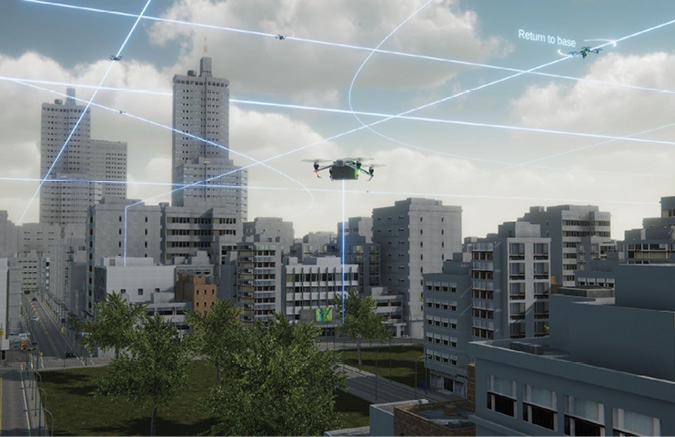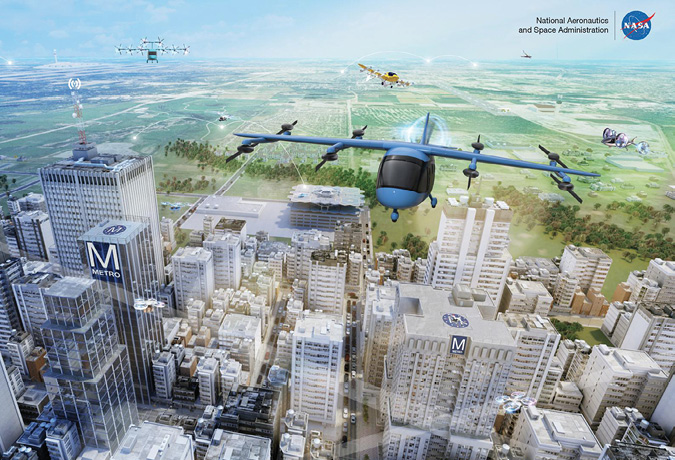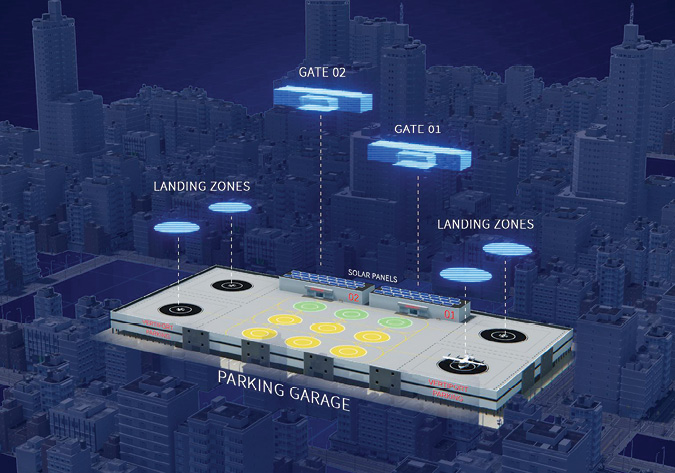NASA is seeking PNT requirements for advanced air mobility when GPS is not available, but the ultimate solution may come in many forms.
At the recent FAA AAM Summit, NASA’s Parimal Kopardekar, one of the main movers in the advanced air mobility field, was asked to name some of the top operational challenges facing AAM in the near term.
One part of his answer: the need for alternative position, navigation and timing (PNT) to buttress GPS, particularly for autonomous aircraft.
The term AAM encompasses a variety of systems, from piloted aircraft that operate much like passenger aircraft today—although they will be much smaller and likely will take off and land vertically—to fully autonomous “air taxis” that will fly autonomously or be operated remotely. As there will be relatively large vehicles flying over busy urban spaces, knowing exactly where each vehicle is located at any given time will be key.
“There are places, particularly urban areas, where there’s multi-path error, GPS is not reliable or is not available,” Kopardekar, universally known as PK, told Inside GNSS in a separate interview. “We would need solutions to be reliably operated in those conditions. There are companies working on it, we are working with a number of alternatives.”
The agency isn’t developing technology on its own, or even moving to select any particular technology, but is instead working to define the requirements for such a system or systems.
“There are a number of good companies and technologies,” he said. “One of the things we are interested in identifying is, what are the requirements for operating in an urban airspace for these alternatives to GPS? We don’t choose technologies, but we identify what the requirements are.”
Possible solutions could be anything from satellite-based systems to ground beacons, or even combinations of multiple systems, he said. Not all the systems are coming from companies with a traditional aviation background.
“There are some traditional aviation, there are some nontraditional aviation, we are working with one SBIR company called Higher Ground, but there are many others,” he said, including NextNav. The company uses terrestrial transmitters, which are essentially ground-based beacons.
The work is part of NASA’s AAM Mission unit, which stood up in 2020 and is intended to “help emerging aviation markets to safely develop an air transportation system that moves people and cargo between places previously not served or underserved by aviation—local, regional, intraregional, urban—using revolutionary new aircraft that are only just now becoming possible,” according to the agency.
NASA has an ambitious schedule for AAM, at least for passenger- or cargo-carrying systems that have a pilot on board, a development expected to arrive sooner than autonomous or remotely operated systems.
“A persistent understanding of positioning is a requirement,” Kopardekar said. “Piloted, you have less of that dependency, it’s just autonomous and such, that’s where it gets really important, I think.”
According to the FAA’s first Advanced Air Mobility Implementation Plan, released in July, some sort of system or systems will be operational by 2028, although that is far from a hard-and-fast date.
“There are places, particularly urban areas, where there’s multi-path error, GPS is not reliable or is not available.”
Parimal Kopardekar,
director, NASA Aeronautics Research Institute
“To address the development of a near-term ecosystem, the FAA created Innovate28 (I28), a joint government and industry initiative that will culminate in integrated AAM operations at one or more key site locations by the 2028 timeframe,” according to the implementation plan.
“For I28, the expectation is that the aircraft will operate from the surface to 4000’ above ground level in urban and metropolitan areas, and in relatively close proximity to or directly on airports. This means that AAM aircraft will operate predominately in or around Class B and C airspace. To operate within Class B airspace, pilots must receive ATC clearance, and aircraft are required to be equipped with an operating two-way radio, Automatic Dependent Surveillance—Broadcast (ADS-B) Out, suitable navigation capability, and an operable transponder with altitude reporting capability.”

One Option: INS
Shortly after Kopardekar was asked about the challenges for AAM, another panelist at the AAM Summit was asked how his company plans to deal with the issue of alternative navigation.
“We believe we have a solution,” said Erick Corona, director of concept of operations and airspace ecosystem development at Boeing-owned Wisk Aero, which is building a four-seat air taxi. “Having said that, the idea is for it to be everybody’s solution and treat it as infrastructure. That is an area where I believe collaboration with the agency and NASA is essential.”
Corona didn’t go into detail at the time, but Wisk has published its own plan, “Concept of Operations for Uncrewed Urban Air Mobility,” which came out in 2022.
“In case of a failure of a position source or a Global Navigation Satellite System (GNSS) system outage, a redundant, multi-source positioning solution (e.g., a tightly-coupled inertial navigation system) will be necessary to ensure the safety of UAM aircraft,” according to the conops document. “Contingency procedures for partial failures of positioning or navigation systems will be designed to ensure safe completion of flights.”
This summer, at the Paris Air Show, Wisk revealed just who would be building that tightly coupled inertial navigation system—France’s Safran Electronics & Defense, which will supply its SkyNaute INS for Wisk’s sixth-generation air taxi.
“We are thrilled to be deploying Safran’s HRG technology as part of this,” Wisk CEO Brian Yutko said. “Our initial testing has confirmed the SkyNaute technology is a step change in navigation system performance and we look forward to deploying it on our 6th Generation air taxi.”
SkyNaute is based on Safran’s patented HRG Crystal Hemispherical Gyroscope, a hemispherical resonator gyro consisting of a number of small parts in a silica half shell, or resonator, made of extremely pure glass.
“It could be compared to making a crystal wine glass ‘sing.’ The slight deformation of the glass generates a wave, and detecting the position of the wave allows measuring its rotation,” according to the company’s website. “The HRG Crystal does not need to communicate externally to determine its position, which makes it fully independent and undetectable.”
The company’s inertial navigation module, named Onyx, is also based on the HRG Crystal gyro. Safran’s inertial navigation systems, whether civil or military or for land vehicles or ships, are now based on the Onyx inertial navigation core, which feature ITAR Free technologies and a modular design, according to the company.
“With very high levels of integrity and accuracy, even when GNSS signals are absent or jammed, SkyNaute hybrid inertial navigation system is designed to ensure the precise trajectory of the Generation 6 self-flying air taxi, during all flight phases, leading to an optimum flight safety,” Safran said, according to a Wisk press release. (At the same show, Safran announced that SkyNaute will also be part of Airbus’ Tiger attack helicopter modernization for vehicles operated by the militaries of France and Spain.)
Another Option: Satellite
Palo Alto, California-based Higher Ground is known for the SatPaq, which it bills as the world’s smallest, easiest to use and most secure satellite communicator. The company began with SatPaq as a consumer product for outdoor enthusiasts but has worked with the FAA and NASA, although its primary customer now is the Department of Defense, President Rob Reis said.
“We’re probably going to solve things first with the DoD because they’re kind of more needy. And then that technology can move over into domestic aircraft.”
Rob Reis, president, Higher Ground
The SatPaq’s basic PC board “is about the size of a credit card,” Reis said. “Okay. It’s a radio and antenna in the package. It’s about the size of a cell phone and we’re the first company to communicate from a pocket size device to geostationary satellites.”
Geostationary satellites are 23,000 miles above the Earth. “And the big advantage—there are several—but the biggest one is they don’t move in the sky,” he said. “And so, for robust connectivity, that really is a big advantage.”
Higher Ground is an 11-year-old startup, which he said isn’t unusual for a company making disruptive technology (with 36 patents granted), which has now caught the eye of U.S. Special Operations Command, the Air Force Research Laboratory (AFRL) and others.
“You end up with really beyond visual line of sight connectivity for the military. A warfighter can put it in their pocket and wherever they go, they know they have connectivity,” Reis said. “From that, we got more and more involved in autonomous air vehicles.”
Although Reis said he and PK stay close, the DoD is working to solve the same issues with autonomous vehicles as NASA and the FAA, “but they have a bigger need and a bigger budget,” he said. “What I’ve discussed with PK is, we’re probably going to solve things first with the DoD because they’re kind of more needy. And then that technology can move over into domestic aircraft.”
Higher Ground has embarked on three technical missions: Pocket messaging from anywhere, including sending small files and photos; TrackPod, which adds a stepper motor to stay in satellite communication, and which can be fitted to autonomous vehicles to provide BVLOS operation; and, for navigation, GEOFix, a jam-resistant GPS surrogate.
“GPS, which is how most people do autonomous navigation, is very easy to jam,” he said. “It’s easy to jam because it’s all on one frequency. Nobody anticipated 50 years ago that there would be such a hacking of GPS.”
That’s where GEOFix, a project with the AFRL, comes in, which has already been demonstrated in two earlier phases. “We’re now into phase three, which is you can do navigation like you do with the GPS satellites, which are MEO, middle earth orbiting satellites. You can do the same thing with GEO satellites and with GEO you got a big, big advantage in that the GEOs typically have 200 to 500 megahertz of pass band, where the GPS satellites are really single frequency. And if you have a whole bunch of spectrum available to you, then you really can be, we call it jam hard, but it’s basically jam resistant because there’s just no way that jamming can keep up with the number of channels that I can put in the sky.”
In short, Reis said, the company is “solving the FAA issues, but we’re first solving them at the DoD level.”
He said SatPaq would be valuable but not critical for piloted AAM systems, but “when you give up the pilot, we’re essential. That’s the same issue with the DoD. There’s plenty of piloted stuff and we provide connectivity on piloted aircraft right now, but for that situation, it’s a convenience. But there’s a ton of money, as you’re probably aware, going into unmanned DoD vehicles. So, on sea, under sea, in the air. We’re a big part of that because you’ve got to have that level of robust connectivity and control.”

Another Option: Terrestrial Beacons
NextNav, based in Sunnyvale, California, has had its beacon system—named TerraPoiNT—evaluated by the U.S. Department of Transportation, NASA and the European Union’s Joint Research Centre.
“We’ve worked with NASA historically…we got the first NASA contract at Langley Virginia, where we deployed a dedicated system around Langley campus to characterize urban drone operations, so they’ve been using it and testing it since 2018 at that facility,” said Ganesh Pattabiraman, the company’s founder and CEO. In late 2022, NextNav announced NASA would use its system for urban air mobility PNT at Ames Research Center.
“We always feel that we are complimentary to inertials and cameras of the world that may be part of the vehicle in any case, so whether it becomes the de facto standard, time will tell, but we feel pretty good where we sit in the marketplace.”
Ganesh Pattabiraman, founder and CEO, NextNav
“Clearly, the system meets many of the requirements they believe are required for future AAM operations,” Pattabiraman said.
He described the hardware as looking like a dorm room refrigerator with an antenna on top, operating nationwide in the company-owned 920-928 Mhz band. “You trilaterate from four of them to figure out your location,” he said. “We’re able to give you position, navigation and time,” the latter from atomic clocks in each transmitter.
The system provides three to four meter vertical accuracy 94% of the time, and for 2D positioning in the five to seven meter range, or better. For on-route operations, “that’s plenty,” he said, although for takeoff and landing greater precision would be required and could be provided by other systems or by installing a beacon at a vertiport.
The system provides GPS-like service in areas, such as urban canyons, where GPS may be blocked or where it could be jammed.
“We are also working with several commercial partners and they recognize those issues. That’s where they come to a system like ours, that can operate independent of GPS and is a terrestrial system and provides the equivalent position, navigation and timing capabilities that can create a resilient layer around GPS that if GPS was unavailable because of building, clutter and blockages, then they can leverage a system like ours, or if it is jammed, also they can leverage a system like ours, because we are about 100,000 times stronger than GPS in signal power, and we are encrypted with our network, so it gives a level of protection that GPS may not be able to provide in these environments,” Pattabiraman said.
Asked whether NextNav’s TerraPoiNT could be a solution for future AAM systems, he said, “We always feel that we are complimentary to inertials and cameras of the world that may be part of the vehicle in any case, so whether it becomes the de facto standard, time will tell, but we feel pretty good where we sit in the marketplace.”
Future AAM Infrastructure
Which of these systems might find their way into a future infrastructure supporting AAM? Possibly any, or all, along with other systems not mentioned here.
“It could be a number of technologies…from satellite providers to ground-based beacon systems, some people use Wi-Fi, people have used geometric location devices, also some of them use fiber optics,” Kopardekar said. “I’m certainly not an expert in any one technology to say one way or other, but I will just say our goal is to understand the requirements rather than any specific technology.”
All images courtesy of NASA.





